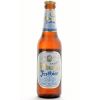Bitburger Brauerei - Bitburger Festbier
-
ABV:
6.2% -
Bottle Size:
330-ml -
Serving Temperature:
45-50° F -
Suggested Glassware:
Willi Becher, Mug, Stein, Pint Glass -
Malts:
Pilsner, Munich, Caramel -
Hops:
Siegelhopfen proprietary blend
Bitburger’s seasonal Oktoberfest-style märzen presents a medium amber hue with copper highlights and very slight haze, topped by a crop of light khaki foam. Unsurprisingly for this style, the nose comes through a bit more malt-oriented than hop-forward. Look for a toasty quality with mild caramel, while hops offer a dash of spicy, herbal perfume. On the palate, we’re impressed by how smooth, supple, and round this is, as the robust malt core offers a nice dose of caramel, lightly sweet toasted bread, and hints of nuts, while some fruity notes appear, conjuring dried fig and wisps of golden raisin. Bitburger’s proprietary “Siegelhopfen” hop blend delivers a pleasantly spicy overtone with very subtle citrus zest, along with mild bitterness to join the hint of stealthy alcohol to provide balance to the malty center. For pairings, the brewery recommends roasted turkey, strong cheese or grilled sausage. We have to point out the pretzel on the label – we think that’s a great idea, especially with authentic sweet Bavarian mustard. Prost!
The brewery which would become the icon known today as Bitburger got its start modestly back in 1817 when a small brewery was founded by Johann Peter Wallenborn in Bitburg, at the southern end of the Eifel mountains in the west of Germany, not far from the Luxembourg border. In 1842, Ludwig Bertrand Simon married Johann’s daughter and took over ownership, naming the brewery Simonbräu, by which it would be known well into the 20th century before transitioning to Bitburger. In 1876, their son Theobald took over operations at the age of 29, and it was under his leadership that the brewery produced their first pilsner in 1883 and began exporting in 1886.
The brewery was cutting edge for its time, with two steam engines in operation by 1896, as well as a refrigeration system coming online that year, as well. A brewery laboratory was built in 1921 to ensure quality and consistency – something that is commonplace now, but not so much back then. By the late 1930s, the brewery had won a gold medal for their Bitburger Pils at the Paris World Expo, and had surpassed 85,000 barrels of annual production.
Sadly, as was the case for so many European breweries, the Bitburger brewery was completely destroyed in WWII. But, reconstruction began almost as soon as the war concluded, and in 1949 production resumed, albeit initially at about half their prewar capacity. Over the course of the next several decades, the brewery continued to grow, with new brewhouses built in 1958 and 1980. In 1990, as the craft beer renaissance was picking up in the U.S., Bitburger established an experimental small-production facility to develop new recipes and styles, and to test new malt and hop varieties. In 2013, the operation was named Craftwerk Brewing, and today the brewery produces a Lager, an IPA, and a Tripel under that name. Bitburger also began collaborating with the U.S.’s Sierra Nevada Brewing Company, co-developing their Triple Hop’d Lager, featured previously in our club.
Today, Bitburger remains one of Germany’s most important privately-owned breweries. In addition to their iconic Premium Pils, they also produce radlers and alchohol-free beers, as well as their seasonal Festbier (this month’s selection) released annually ahead of Oktoberfest.

Unmatched Variety by style, brewery & country
Choose from Five different Beer Clubs offering unmatched variety by brewery,
country of origin, and beer style to suit your specific tastes.


